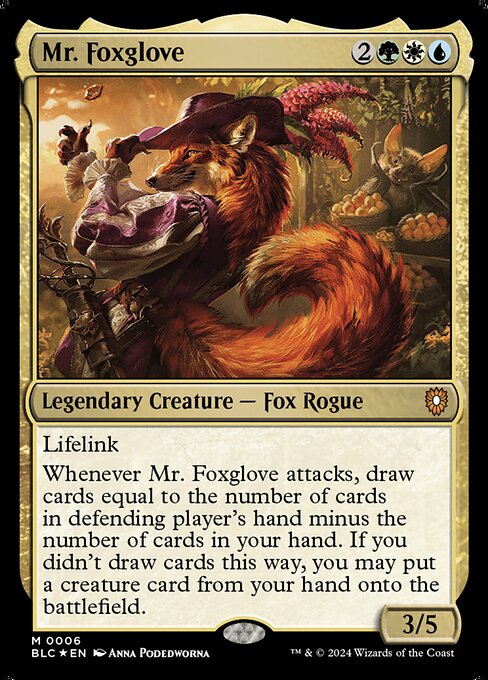
Image courtesy of Scryfall.com
Countering a three-color lifelink threat on the bloom-filled battlefields
Three-mana on paper becomes five mana in reality when you’re deploying a legendary Fox Rogue with Lifelink and a dynamically punishing attack trigger. Mr. Foxglove, a creature from Bloomburrow Commander, slides into any G/U/W heavy roster as a value engine that tests how you manage tempo, card advantage, and hand-size dynamics. The card’s printed identity—green, blue, white—speaks to a design philosophy: blue for control, green for growth, white for order. When it attacks, you draw cards equal to the defending player’s hand size minus your own. If that draw doesn’t happen, you may cheat a creature onto the battlefield from your hand. It’s a puzzle box wrapped in a lifelink bow, and it asks players to think several steps ahead. 🧙♂️🔥
In practice, the best defense often becomes a proactive game plan: dampen the draw engine, control the battlefield, and force smart decisions before the swing lands.
How the key ability plays out in real games
Understanding the trigger is half the battle. On the attack step, the defending player’s hand size and your hand size determine how many cards you draw from Foxglove’s attack. If the defending player holds more cards, you gain resource momentum; if you’re the one with more cards, the draw ceiling drops. If the computed number is zero or negative, you draw nothing, but you still may put a creature onto the battlefield from your hand. That last clause—the potential cheat—a powerful backdoor that can swing a combat on the heels of a missed draw. It’s this dual-path design that makes Mr. Foxglove a thorn in the side of slow-control strategies and a carrot for bold, pay-off-oriented lines. 🎲💎
Practical counterplay: how to blunt its impact
- Disrupt before combat: The surest way to blunt Foxglove is to stop it from attacking or to remove it from the battlefield before the trigger resolves. Targeted removal or a timely bounce spell can prevent an entire sequence of draws and potential cheats. In commander games, this often buys you the needed tempo to stabilize the board. ⚔️
- Hand-size parity through disruption: The attack scales with hand sizes. If you can force the Foxglove controller to discard or temporarily drain their hand, you can shrink the potential draw. Black and blue discard effects, plus hand-hate packages, are popular in multiplayer formats for exactly this reason. 🧙♂️🪄
- Counter magic where it counts: A well-timed counterspell targeting Foxglove as it tries to attack or as it enters the battlefield can erase the threat entirely. Keeping a cushion of mana and a few counterspells ready is part of the defensive playbook against multi-color value engines. 🔒
- Board presence and post-attack planning: If Foxglove lands a swing, you’ll want to respond not just with removal, but with board-state resilience. Wipes or wipes-like effects, combined with evasive threats, push Foxglove into a position where its subsequent turns are less explosive. A thoughtful turn or two can flatten its best-case outcomes. 🎨
- Defensive hand management: For defenders, keeping your own hand small isn’t always best. But in the context of this card, strategic discards or draws on your opponent’s turn can help you land the moment where their draw is minimized, and your own threats can push through without granting them a huge advantage on the next swing. 🧭
Deck-building angles: building around a tri-color threat
In Bloomburrow Commander’s ecosystem, you’ll find that Mr. Foxglove rewards decks that harmonize control and value engines. Since its mana cost hits the G/U/W identity, you’ll want reliable blue countermagic, white removal, and green ramp to stay ahead of the curve. Consider incorporating hand disruption packages that can whittle down an opponent’s threatening options while you keep your own card advantage in check. And because Foxglove’s attack can cheat in a creature if you didn’t draw, it’s smart to include a few well-timed blockers or blink effects to reset the board state without giving the Foxglove player a second chance to stack the attack. 🧙♂️⚔️
The card’s lifelink keyword also adds a survivability angle—your life total is part of the resource race here. In long multiplayer games, that lifelink isn’t just a stat; it’s a potential supply line that affects how aggressively you push through removal and how much you value your own card draw engines. Strategically, Foxglove isn’t a pure combo piece; it’s a demanding, interactive threat that rewards precise sequencing and disciplined hand management. 💎🎲
Meta perspective: why this matters for players who love the thrill
What makes a card like Mr. Foxglove resonate is how it threads the needle between tempo and value. It requires players to think not just about “can I kill it” but about “how will my hand size shape the next few turns?” That kind of cognitive load is what MTG fans adore—where every combat, every draw, and every creature cheat becomes a narrative moment. In the broader meta, the card nudges tables toward more interactive combat and thoughtful disruption, rather than pure power spikes. 🧙♂️🔥
Product spotlight
On game nights or during a fun stream, you’ll want a reliable companion for life’s little interruptions. This sleek accessory is designed to keep devices safe and stylish while you plot your next strategy session. The link below pairs nicely with the spirit of thoughtful play that MTG fans bring to the table.
Clear Silicone Phone Case — Slim Durable ProtectionMore from our network
- https://blog.digital-vault.xyz/blog/post/decoding-character-references-in-reckless-cohorts-flavor-text/
- https://blog.rusty-articles.xyz/blog/post/foundation-breaker-analyzing-name-semantics-for-mtg-fans/
- https://transparent-paper.shop/blog/post/designing-procreate-brush-packs-for-illustrators-a-practical-guide/
- https://blog.digital-vault.xyz/blog/post/why-brambleghast-became-pokemons-visual-icon/
- https://crypto-acolytes.xyz/blog/post/hot-vs-cold-crypto-wallets-which-is-safer/